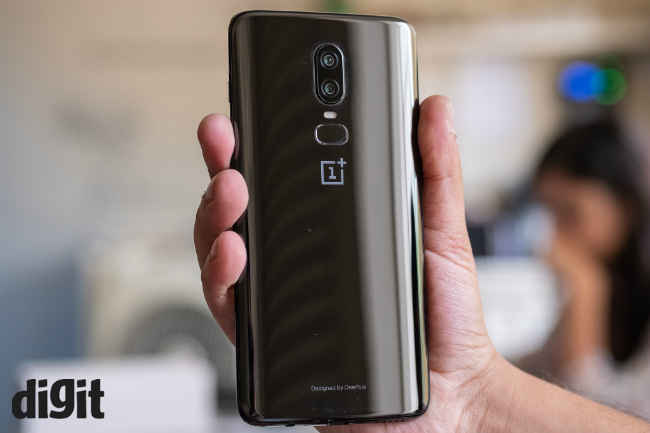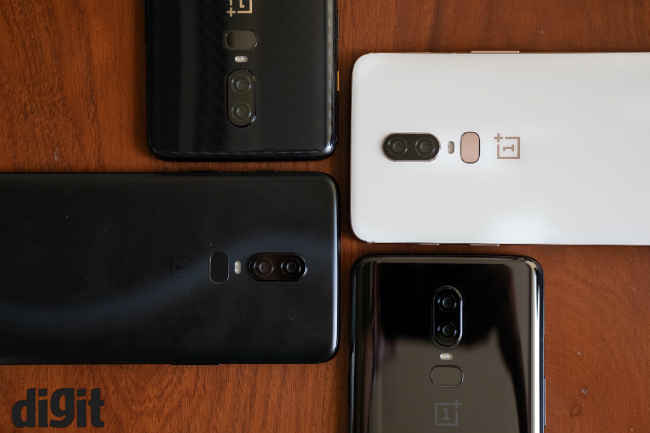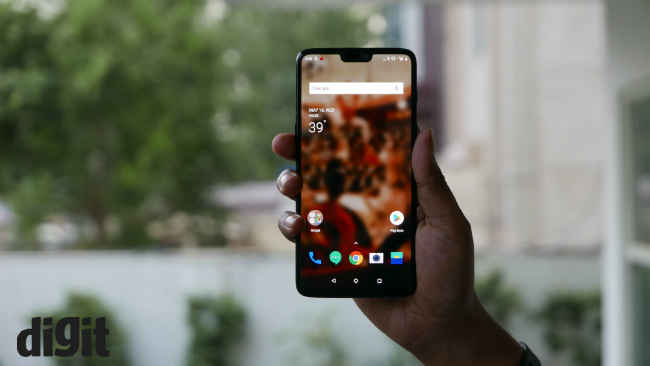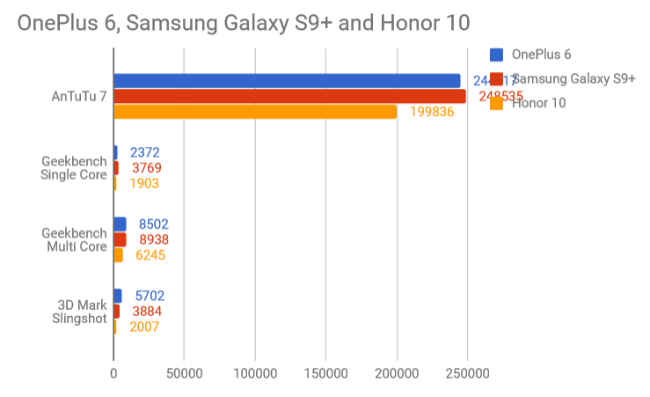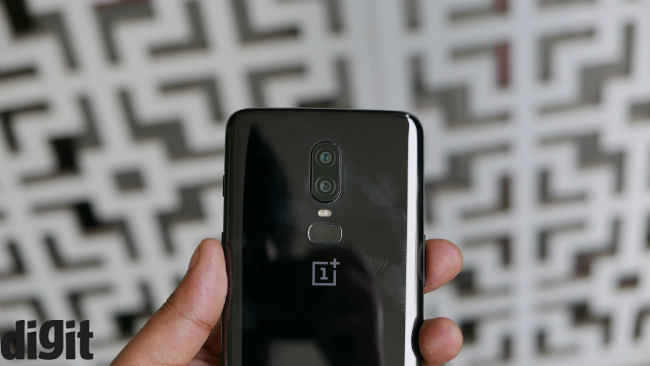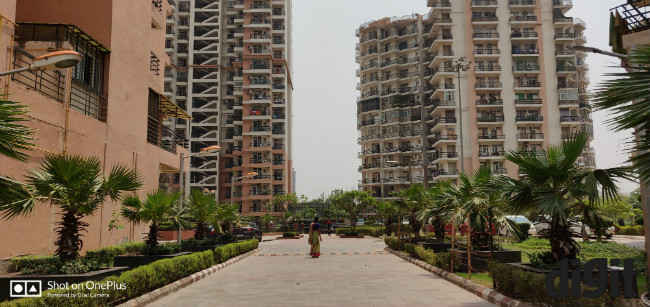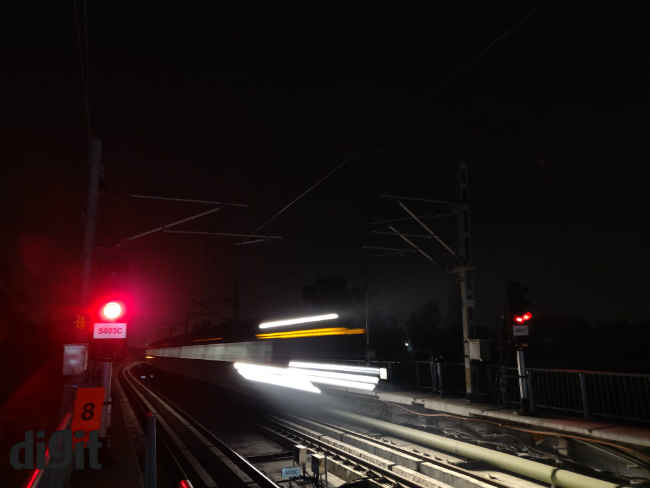OnePlus 6 Review : The speed demon returns
The OnePlus 6 is built for speed from the ground up. The smartphone has the history of being a flagship killer, but despite the top-of-the-class hardware, the compromises in OnePlus phones have also remained consistent, so much so, that it is now acts as a deterrent to buy this over an expensive flagship. The OnePlus 6 is still just as fast, even more beautiful but has the same flaws as last time.
The OnePlus 6 ticks off all the features that are setting the trends in 2018. The notched display. A glass design. Vertically aligned dual cameras. Portrait selfies, and what not. Yet, while it chases the majorly noticeable trends, the OnePlus 6 does compromise on the features that go a long way in making a phone durable and future-forward. It is this balance of premium offerings and compromises that makes reviewing the OnePlus 6 that much interesting. Add to that a supremely value-for-money price of Rs 34,999 and it becomes all the more difficult to not be swayed by it. Nevertheless, this has been one of the most anticipated device of this year and here’s what we think of it.
Design: Look the part, be the part
OnePlus has always tried to bring what the premium phone-makers offer to a much lower price segment. That way, the OnePlus 6 takes after both the iPhone X and the Galaxy S9. It combines the best of both phones to offer a convincing flagship. From the front, the OnePlus 6 is quite akin to the iPhone X because of the notch. From the back, the vertical camera alignment placed centrally is something Samsung did with the Galaxy S9+ earlier this year. But it's not all borrowed. The signature OnePlus curve, where the back panel curves gently to meet the edges is still there. It helps a lot when gripping the phone. But more importantly, it's the meticulous attention to detail OnePlus has paid in making the phone that scores a lot higher in my books.
Glass is all the rage these days. Every phonemaker has suddenly decided to ditch the reliable metal unibody design for a glass back. Some did it to provide wireless charging which needs a glass back to facilitate electromagnetic induction, while others did it just for the kicks. OnePlus falls in the latter category. The OnePlus 5T had an extremely durable design. I have used the device as my daily driver for months and it survived every attack on its life. OnePlus did make the glass panel out of Corning Gorilla Glass 5 which has a reputation of being able to survive drops, but will it be as durable as a metal-bodied phone? OnePlus is certainly guaranteeing it, although history is not on its side. The glass design also adds to the weight. The OnePlus 6 is certainly heftier than its predecessor, but that doesn't really mess with the ergonomics.
Aside from the fear of the glass cracking, the material has given OnePlus the freedom to experiment with how the OnePlus 6 looks and feels. There are three distinct finishes which aren't just different colours. The mirror black variant that I received for the review has been polished to give a ceramic-like feel. It's actually like a mirror and you can see your face distinctly on it. The matte black is much like the older OnePlus 5T with a smooth, matte texture. There's also a Silk White variant which is where I would put my money on. OnePlus gave a shimmering effect to the variant by sprinkling pearl powder in the glass body. The white variant also has rose gold accents around the edges and the camera unit. Finally, there's the limited edition Avengers: Infinity Wars Edition that has a chequered pattern at the back with the Avengers logo etched in gold.
The OnePlus 6 is also a lot thicker than its predecessor. The screen takes up most of the real estate up front and the bezels at the bottom are much smaller than that of its predecessor. On top is of course, the notch (more about that later.)
The OnePlus 6 is designed to be functional. The useful alert slider has been shifted to the right side and it now sits above the power button while volume rocker is on the left. The fingerprint sensor sits very close to the camera unit at the back. It is also oval-shaped, a departure from the circular sensor used in the OnePlus 5T. It reduces the surface area making it slightly difficult to use.
Overall, the OnePlus 6 retains the minimalist and functional design that has been propped up with a glass body to give a premium flair to the phone, albeit with a few hiccups. As much as what the company likes to claim that Gorilla Glass 5 is as durable as a metal-bodied phone, we have seen multiple instances of phones with the same Gorilla Glass 5 shattering. I’d take OnePlus’ claim with a pinch of salt here.
Display: A notchy affair
The OnePlus 6 has the biggest display seen on a OnePlus device ever. Does that mean the size of the phone has increased? No. The OnePlus 6 is of the same size as the OnePlus 5T. Yet, thanks to the notch on top, the display size has increased to 6.28-inches and now has a screen-to-body ratio of almost 84 percent. The extra space up top which is interrupted by a notch now houses the status bar including the clock and notification icons. OnePlus' reason for the cutout in the display is that it gives more screen real estate to content. The status bar is kept a level higher while the entire area below the notch is used up by the content. It isn't quite intrusive as I thought. When a video is playing on YouTube, the notch gets disguised by the AMOLED panel blacking out the area. Although, it comes in the way when you are viewing a photo taken by the phone in the 19:9 format. In that case, the photo gets cropped in an ugly manner around the notch.
It's easy to get used to the notch though. After a point, you won't even realise it's there. And it's better to accept the odd design choice as it's not going anywhere anytime soon. Every phone maker this year has gone for the same design choice, and it seems to be a stopgap solution till someone figures out how to make a complete edge-to-edge panel.
The display, otherwise is much brighter than before. The pixel density has increased adding more sharpness to the content. It's a bummer to not see a QHD display on the phone that claims to be the flagship killer. But the 1080p resolution AMOLED panel works just fine in handling content. It has support for NTSC and DCI-P3 colour gamuts which you can toggle around in the Settings app. The adaptive brightness works like a charm, intelligently tweaking the screen brightness to suit the light outside. Being an AMOLED panel, it's quite legible under direct sunlight, although there is an expected colour loss at peak brightness. The display also seems to be slightly on the warmer side with a soft yellowish tinge on colours.
The OnePlus 6 retains the Reading Mode which was introduced in the OnePlus 5. Turning it on simulates an e-ink panel to be less strainful to the eye. It's great if you have a habit of reading long articles or e-books on your phone.
The display is the center of attraction here, and while it isn't as dazzling as the Galaxy S9, it's once again functional. A word about the touch latency here. One of the reason why the OnePlus 6 feels so smooth is because the display is more sensitive to touch than usual. It's similar to how the OnePlus 5 and the 5T were tuned to be more responsive to touch. Try using the Galaxy S9 and the OnePlus 6 side by side and you’ll get the difference. It shows how focused OnePlus has always been about speed.
Performance and UI: Fast AF
The OnePlus 6 is the first phone in India to be powered by the Qualcomm Snapdragon 845. Needless to say, it's the fastest mobile platform available for Android devices right now. The chipset rocks eight custom Kryo cores that can hit a max speed of a whopping 2.8GHz. Since Samsung's Exynos chipset maxes out a 2.2GHz on the Galaxy S9, the OnePlus 6 is officially the fastest phone in India right now. At least on paper. Although, benchmark reports will peg the Galaxy S9 slightly higher than the OnePlus 6. The AnTuTu 7.0 score was 244517 while the OnePlus 6 scores 2372 and 8502 on Geekbench Single Core and Multi-core CPU test respectively. The Adreno 630 GPU on the phone is also quite powerful in simulating graphics. The 3DMark Slingshot score it received was higher than even the Galaxy S9 at 5702. How does all this convert to real life?
Well, it's certainly fast and if you're thinking of upgrading from the OnePlus 5T, you're likely to not feel the difference at all. The phone can switch between apps in a snap, open apps in an instant and while gaming, there's never a frame drop. The Game Mode that was a hit among users in the 5T has been improved by allowing users to take calls from the speaker while in a game, apart from limiting other apps from accessing the network to allow online games like PubG mobile to have lower latencies. The phone also switches between WiFi and mobile data in an instant.
Perhaps it's the lack of heavy animations in OxegenOS which powers the OnePlus 5T that makes operations feel super smooth and super fast. The notification shade and the app drawer are accessed in milliseconds while the scrolling down long lists has no stutters whatsoever. It's amazing how a well-optimised device can work so smoothly. Even the Galaxy S9, over a period of use tends to stumble and stutter at odd times, but the OnePlus 6 has so far proven to be flawless over a week or so of use. I loaded the phone with all sorts of apps, but nothing deters this beast.
A significant portion of the smooth operation can be attributed to the 8GB LPDDR4X RAM that turbo-chargers the performance by always keeping extra resources available on demand. During my time of use, I saw around 2GB of RAM free most of the time, even when a graphics-intensive game, Chrome browser (with 20 tabs), and four-five other odd apps were open. The OnePlus 6 offers up to 256GB of storage. The base variant has 64GB of storage. The choice of including UFS 2.1 storage also helps with improving the speed.
TL,DR: The OnePlus 6 is fast.
The OxygenOS interface, OnePlus claims now opens apps 11 times faster. Considering how fast it anyway was, the difference is hardly noticeable. The interface is still as near to stock Android I've seen yet housing a lot of optimisations and tweaks. A quick glance through the Settings App will tell you the plethora of features the OnePlus 6 brings to the table. There's some India-centric features as well — Long pressing the fingerprint scanner opens the Paytm QR scanning page instantly. Swiping right from the home screen brings up the dashboard which shows the amount of data used, storage available, recent apps opened, favourite contacts and more.
What's new in the OxygenOS is the new gestures support. It's works more similar to that of iPhone X's than Android P. Swiping up from below takes you back, swiping up and holding brings up the recent apps while swiping up from the centre brings up the homescreen. It does have a learning curve but once you're used to it, it feels intuitive. However, what needs time to get used to is the typing experience. Because of the gestures, the navigation buttons are no longer needed, which brings the keyboard a level down. This screws with the muscle memory and causes a lot of typos while typing. Apple tackles this with a white bar below the keyboard to maintain the older position.
There's also no machine-learning mumbo-jumbo in the phone, or at least the company won't admit using any. OnePlus skipped any mention of the AI buzzword during the launch keynote and by the looks of it, the phone allows superfast operation regardless of whether it's the first time you're opening an app or for the hundredth time.
Camera: The camera you deserve, not the one you need
The camera(s) at the back of the phone is now one of the most important aspect of choosing a smartphone. And that's where the OnePlus 6 falters. The phone uses a 16-megapixel + 20-megapixel dual camera stack at the back. That's the same resolution as the OnePlus 5T but few things have changed inside. The OnePlus 6 now uses a newer Sony IMX 519 sensor along with a larger pixel pitch of 1.22um. It's dual camera implementation has also changed. The secondary 20-megapixel camera is now used to simulate the depth of field for portrait shots and for faster autofocus. That's different from last time when the second camera was first used to get 2X hybrid zoom on the OnePlus 5 and then to shoot in low light in the OnePlus 5T.
The newer upgrades, truth be told, doesn't convert to 'better' images. It's just as good as its predecessor, which isn't in line with the philosophy of OnePlus phones. Users look forward to the upgrade when they put in money to buy a OnePlus device. Moreover, the company likes to position itself as a flagship under an affordable price. But it's mostly the cameras on phones like the Samsung Galaxy S9 that justifies the extra cost. When it comes to the imaging prowess on the OnePlus 6, you get what you pay for, which isn’t much.
But that doesn't mean the photos are all that bad. The OnePlus 6 takes well-lit, bright and sharp photos in daylight. It's HDR algorithm is quite adept at bringing out details in the shadows while the image itself isn’t overexposed. The colours are actually quite close to neutral. Indoors, the phone balances the lights and shadows quite well and the details are sharp enough. OnePlus once again avoided any mention of using AI to improve photos, so I'm presuming there's nothing of that sort.
The weakness is in the low light imaging. Photos taken under poor lighting tend to lose out on the details. The dynamic range is low and sharpness is lacking. There's also an ugly glare from the source of light which didn’t go even after cleaning the lens. Safe to say, it isn't going to dethrone the Pixel 2 or the Galaxy S9 anytime soon in low light photography.
The Portrait Mode is quite adept at subject separation. The subject is separated from the background consistently without overly softening the background. The depth of field actually feels a lot more natural than before, which many might interpret as underwhelming, but it’s not. Furthermore, OnePlus now gives the options to tweak the shape of the bokeh. You can switch between heart-shaped, circle and star-shaped bokehs. The depth of field effect by OnePlus produces creamy bokehs which is perhaps the best part about the camera.
What’s irksome is that OnePlus had a perfectly good solution for providing 2X hybrid zoom in the OnePlus 5, but they walked away from it on the OnePlus 5T and now the OnePlus 6. The zoom in the OnePlus 6 is completely digital, and no matter how much OnePlus claims they use multi-frame processing to get a clean zoom, there’s a significant and noticeable loss in detail with a lack of sharpness.
Battery: Fast discharge, Dash charge
The OnePlus 6 is powered by a 3,300mAh battery that feels palty in comparison to what the power banks-disguised-as-phones like the Huawei P20 PRo provide. And that shows when you’re using the phone. Because of the high-end hardware, the battery drains quite fast, so much so, that you are left with around 5-6 percent of battery after a typical work day. It does need a top up in the evening if you decide to head out after work. That topup is provided by the Dash Charger that can fully charge the battery under an hour. The Dash Charger remains an integral part of the OnePlus experience. It’s the reason why OnePlus can get away with putting a smaller battery on its phones every time. In the PCMark Work 2.0 Battery Test, the phone lasted 5 hours 46 minutes which isn’t up to the standards at all. Interestingly, the benchmark test revealed the discharge is consistent till 20 percent after which it drops drastically. So, when you see the phone’s battery drop below 20 percent, understand that it’s time to plug the charger in.
Bottomline
Over time, the flagship killer status that OnePlus devices enjoyed exclusively has been eroded slowly and steadily. Other incumbents like the Moto Z2 Force, Mi Mix 2, and more importantly, Honor’s devices also offer similar hardware configuration at that price. But the fact remains, in the high-end segment, OnePlus enjoys unparalleled brand loyalty. Users of OnePlus devices are never unhappy and the company works hard to keep it that way. But over time, as the flagship phone-makers are looking to differentiate themselves from others not just in terms of brute hardware prowess, but also in terms of unique features, OnePlus is finding itself in a tight fix. The main selling point of OnePlus devices is the hardware which the company provides at an unparalleled price point, which is always 30 to 40 percent lower than the going price for a flagship. Years of positioning itself as the flagship killer has raised expectations. So when the OnePlus 6 compromises on things like an IP rating for water resistance, or a good enough camera, it hits harder. The company’s focus for the OnePlus 6 has all been about Speed, but it would seem that in the process, they may have ignored some other important aspects. If you’re in the market looking for a fast and reliable performer, the OnePlus 6 is a no brainer. However, if you find yourself debating between a flagship and the OnePlus 6, then the choice gets much harder due to the corners cut by OnePlus.

